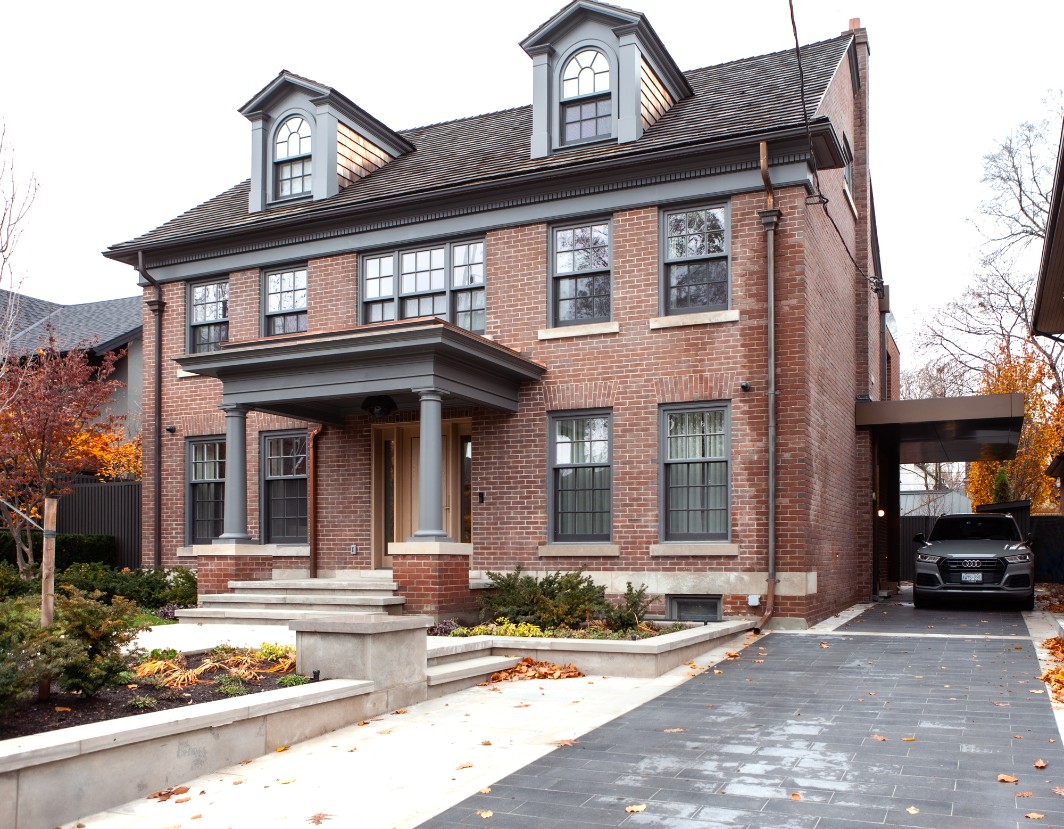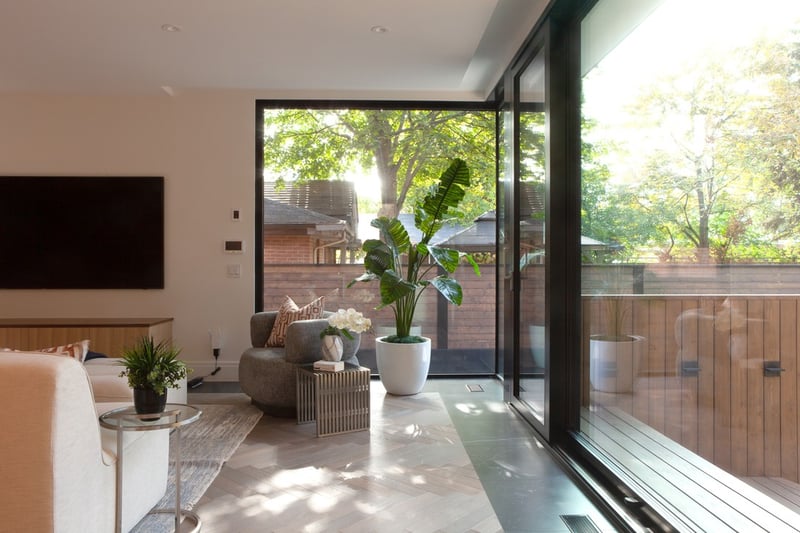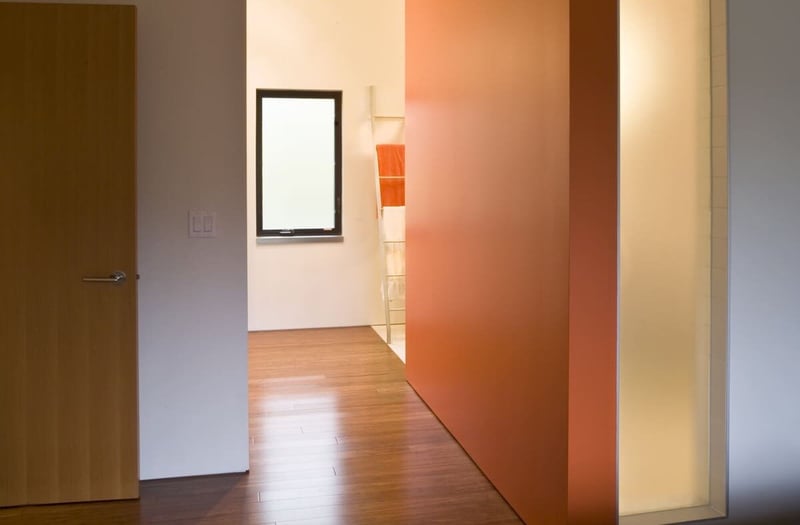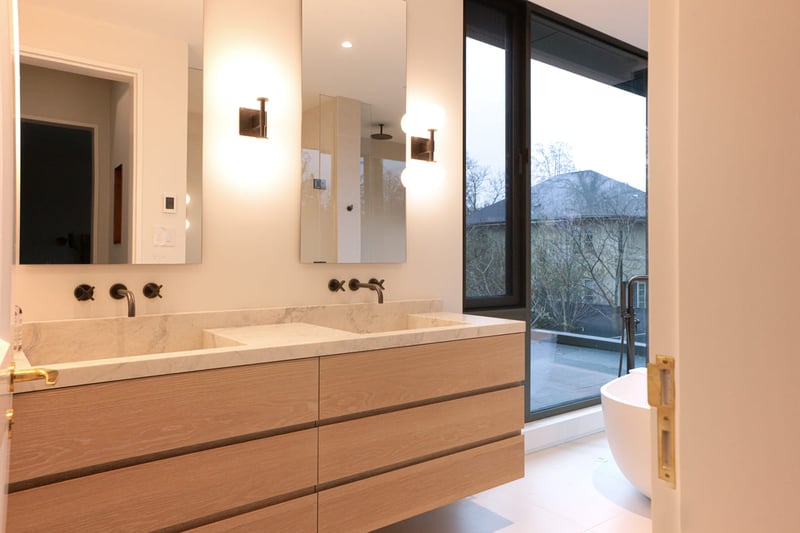
Expert Insight: Addressing Common Problems in a 100-Year-Old Toronto Home
Owning a century home in Toronto is a privilege, but it comes with challenges that modern homeowners don’t always anticipate. Behind the charm of original woodwork, intricate mouldings, and solid masonry walls lie outdated plumbing, inefficient heating systems, drafty windows, and structural issues that have developed over decades. A beautifully preserved historic home in Toronto may look timeless, but without the right renovations, it can feel anything but. For those considering an old home renovation, understanding the unique needs of 100-year-old houses is essential. The best old home renovations go beyond surface-level updates. Renovating a historic home is an investment in both craftsmanship and modern comfort, blending time-honoured architecture with state-of-the-art building science.
SevernWoods Fine Homes has created this guide to provide in-depth information on the most common problems with 100-year-old homes so that you can arm yourself with the insight you need to give your home another beautiful century.
Table of Contents
- Foundation & Basement Issues in a 100-Year-Old Toronto Home
- Common Foundation Problems in Historic Homes
- Air Sealing & Insulation in a Century Home
- Common Flooring Concerns in Toronto's Historic Homes
- Upgrading Windows and Doors in a Century Home
- Modernizing Heating & Cooling
- Replacing Plumbing in an Old House
- Electrical Upgrades & Knob-and-Tube Wiring
- Work With Experts Who Understand Historic Homes
Foundation & Basement Issues in a 100-Year-Old Toronto Home
For homeowners investing in an old home renovation, addressing foundation problems early is essential. A home’s foundation is its structural backbone, and in old Toronto houses, that often comes with hidden vulnerabilities that influence the rest of the home.
Common Foundation Problems in Historic Homes
Crumbling or Deteriorating Masonry
Many 100-year-old houses in Toronto were built with double-brick or stone foundations, which have stood the test of time but are not impervious to wear. Mortar joints degrade over time, allowing moisture to seep in, which weakens the structure. Signs of deterioration include the following.
-
Spalling or flaking bricks
-
Crumbling mortar between stones or bricks
-
Dampness or white powdery efflorescence on basement walls
Shifting & Settling Foundations
Natural soil movement, poor drainage, and original construction methods often lead to uneven settling, which can cause common issues with foundations.
-
Visible cracks in basement walls or ceilings
-
Doors and windows that no longer close properly
-
Floors that slope toward the centre of the house
In many cases, settling is a slow process, but when left unaddressed, it can lead to significant structural problems requiring extensive and costly repairs.
Water Intrusion & Poor Drainage
Many older homes were built without the waterproofing systems required to keep basements dry. As a result, many century homes suffer from water-related foundation issues.
-
Damp, musty basement air
-
Standing water or moisture seepage after heavy rain
-
Mold growth and efflorescence on basement walls
Underpinning: Transforming the Basement Into Usable Space
Basements in century homes were not designed for modern living. Ceiling heights often range between five and six feet, far from the standard for today’s finished basements. For homeowners looking to increase living space and improve foundation stability, underpinning offers a solution.
-
Excavating below the existing foundation to increase ceiling height
-
Reinforcing the foundation to prevent future settling
- Waterproofing and insulating to create a dry, comfortable space

Air Sealing & Insulation in a Century Home
Older homes were not built with energy efficiency in mind. A common issue with historic homes in Toronto is excessive air leakage, leading to high energy costs, uneven heating, and overall discomfort. Without modern insulation, these homes can feel cold in the winter, hot in the summer, and drafty year-round.
Why Old Homes Leak Air
Old homes have no vapor barriers, allowing cold drafts to seep through cracks in brick, mortar, and window frames They typically include poorly sealed window and door openings and gaps around floor joists and wall cavities where warm air escapes.
The result is an inefficient home that is difficult to heat and cool properly.
Best Practices for Air Sealing an Old House
Air sealing an old home requires a balance between improving energy efficiency and preserving architectural integrity. Unlike modern homes, historic houses were designed to breathe, meaning completely sealing them without a proper plan can create moisture issues, trapped condensation, mold growth, and material deterioration. A well-executed air sealing strategy ensures that while drafts and energy loss are minimized, the home can still manage moisture properly.

The Interior Insulation Approach
One of the most effective methods for air sealing a century home is to remove the original plaster walls and construct a new insulated stud wall inside the existing masonry. This approach allows for proper insulation while preserving the home’s exterior brickwork or stone facade. However, simply adding insulation without first addressing air leakage is ineffective.
To create a truly airtight envelope, a peel-and-stick air barrier can be applied directly to the interior brick before the new framing goes up. This method prevents air infiltration while still allowing the walls to handle moisture properly, preventing condensation buildup that could damage the structure over time.
Spray Foam Insulation: A One-Step Solution?
One of the most commonly used solutions for air sealing old homes is spray foam insulation, which both insulates and seals air leaks in one step. When applied inside the new stud cavity, it provides maximum insulation value per inch, making it an attractive option for homes where space is at a premium.
However, many homeowners prefer to avoid spray foam due to its environmental impact, high cost, and fire-related concerns. If spray foam is used, it must be installed correctly to avoid trapping moisture between the insulation and the home’s original masonry walls, which can cause long-term damage.
Alternative Air Sealing & Insulation Methods
For homeowners looking for a more traditional, breathable approach, a combination of air-sealed Rockwool or fiberglass batt insulation with a properly installed vapor barrier can be used. These materials do not offer the same airtight seal as spray foam, so extra attention must be given to sealing all potential air leakage points.
Common problem areas for insulating an old house include:
-
Windows and door casings: Air can escape through gaps around old frames.
-
Floor joists and wall penetrations: These are areas where electrical and plumbing run through the walls.
-
Attic and basement connections: These are major points of heat loss if not properly sealed.
Curious about the costs for renovation this year? See our recently updated pricing here.

Common Flooring Concerns in Toronto's Historic Homes
Why Floors Squeak
Squeaks in the floor are caused by wood rubbing against wood or, more often, by wood rubbing against nails. Original subfloor pine boards were usually installed at a 45-degree angle across the floor joists using smooth shank common nails. Over time, subfloor boards shrink. This causes nails to back out a little bit, and the subfloor boards become springy and are no longer fastened tightly to the joists below. This springiness allows the boards to move up and down on the nails, making the floor squeak whenever someone steps on it.
Why Floor Joints Fail
Another common flooring problem in older homes is joint failure. Original hardwood “strip” flooring was usually constructed from locally grown oak or maple, with tongue-and-groove wood strips nailed to pine subfloors with finishing nails. These strips were generally 1-3/4” wide and just 3/8” thick.
If previous owners decided to sand and refinish these floors one or two times since they were originally installed, the flooring can easily become too thin. If too much material is removed, the tongue-and-groove joints usually fail.
Four Causes of Uneven Flooring
The floors in most older homes are not level or true, and the difference between high and low spots can be as much as two inches, depending on how well the original home was engineered and constructed. There are four main causes of uneven flooring in older homes. Two of these are related to the floor joists themselves, and two are related to basement foundation issues.
Undersized Floor Joists
The first-floor joist issue is that most modest older homes were constructed using undersized floor joists for the spans and loads they were required to support. The resulting overloading of the joists causes permanent bowing of the joists and subsequent unevenness in the floor. These floors rarely fail completely, but they are not level and may bounce.
Overloaded Floor Plate
The second flooring problem is when a floor plate has been overloaded with a wall that is offset to a beam below. The resulting high spot or ridge in the floor exists above the beam because the offset loading has caused the joists to bend excessively.
Small Column Footings
If your home’s floor joists are not the issue, you may be looking at a foundation problem. Floors can be uneven when a beam in the basement is supported by columns. (These columns may be made from a variety of materials, but brick is the most common). In most homes, the footings of internal columns were not sized large enough to support the loads that they held. Because of this, the footings under columns settle into the soil more than the foundation walls have settled. This results in a low area in the floor above the beam and usually a sagging floor in the middle of the home.
Uneven Perimeter Flooring
The final and least common flooring problem occurs when the floors are not level around the perimeter of the floor plate. In some cases, the house may have been built this way, but more commonly, the foundation has settled unevenly and sometimes universally so that no cracks have appeared in the foundation wall.
Upgrading Windows and Doors in a Century Home
Many historic homes in Toronto still have their original wood-frame windows, which, while beautiful, offer little in terms of insulation or energy efficiency. These homes were built long before double- or triple-pane glass became standard, meaning single-pane windows allow significant heat loss in the winter and heat gain in the summer.
Replacing windows and doors is one of the most effective ways to improve energy efficiency, enhance comfort, and reduce drafts, but it must be done carefully to preserve the historic character of the home.

Are Original Windows Worth Saving?
In some cases, restoring original windows is possible, particularly if the frames and sashes are in good condition. Homeowners looking to maintain architectural authenticity may choose to:
-
Re-glaze existing wood-frame windows with modern insulated glass
-
Add interior or exterior storm windows to improve thermal performance
-
Refurbish old frames and sashes to ensure a proper seal
However, many old windows were replaced decades ago with lower-quality materials. If your home has inefficient aluminum or vinyl replacements from the mid-century, it’s often best to upgrade to custom wood or wood-clad windows that match the original design while providing modern insulation.
Choosing the Right Replacement Windows
There are excellent modern options for homeowners who want to replace their windows without compromising the home’s character.
-
Custom-built wood or wood-clad windows that match the original profiles
-
High-performance double- or triple-pane glass for improved insulation
-
Fiberglass or composite frames that mimic the look of wood but require less maintenance
Proper installation is critical. Poorly fitted windows can still allow air leakage, negating their energy benefits. Additionally, modern low-profile weatherstripping and sealing techniques help maintain the home’s historic aesthetics while eliminating drafts.

Sealing Air Leaks Around Windows & Doors
Many old Toronto houses still experience significant air leakage around window and door frames due to natural settling over time, deteriorating caulking, and outdated or missing weatherstripping. These small but persistent gaps allow air infiltration, making it harder to regulate indoor temperatures and increasing energy costs. A thorough inspection of all windows and exterior doors is essential to identify weak points, followed by proper sealing with high-performance caulking around trim, low-profile weatherstripping that preserves the home’s aesthetics, and insulated jamb extensions to eliminate thermal bridging.
Modernizing Heating & Cooling Systems in a Century Home
Most 100-year-old houses were not built with forced air heating or central air conditioning. Instead, they relied on coal or oil-fired boilers, which distributed heat through large cast-iron radiators. While these systems were effective for their time, they offer little temperature control and no cooling options.
For homeowners undertaking a full old home renovation, upgrading the heating and cooling system is crucial for comfort, efficiency, and long-term sustainability.
Replacing Old Radiators and Boilers
Many historic homes still have their original radiators, and while they provide even, long-lasting heat, they often miss the mark on today’s comfort expectations.
-
Lack zoned temperature control, meaning the whole house is heated at once
-
Require oversized pipes, which take up space inside the walls
-
Cannot accommodate modern cooling systems
Modern Upgrades for HVAC Systems
-
High-efficiency boiler systems that retain radiant heating but with improved control
-
Radiant in-floor heating, particularly for bathrooms and basements
-
Hydronic baseboard heating, which takes up less space than old radiators
For homeowners who prefer forced-air heating, a new high-efficiency furnace with custom ductwork can be installed. However, ductwork modifications must be planned carefully to avoid disrupting the home’s original architecture.

Adding Central Air Conditioning to an Old House
Because most century homes were built without ducted systems, retrofitting central air conditioning can be challenging. Homeowners typically choose between the following options.
-
High-Velocity HVAC Systems: Uses small, flexible ducts that can be installed with minimal disruption to walls and ceilings
-
Ductless Mini-Split Systems: Provides zoned heating and cooling without requiring extensive ductwork
-
Traditional Forced-Air Systems: Requires full duct installation, best suited for homes undergoing a major renovation
Regardless of the system chosen, improving the home’s airtightness and insulation first ensures that heating and cooling systems run more efficiently, reducing long-term energy costs.
Replacing Plumbing in an Old House
Plumbing systems in 100-year-old houses were not designed for modern living. Many older homes in Toronto still rely on galvanized steel, lead, or cast iron pipes, all of which degrade over time. Aging pipes are prone to corrosion, mineral buildup, and leaks, leading to poor water pressure, inconsistent temperatures, and potential health hazards. While some homes may have undergone partial plumbing upgrades over the decades, many still have a mix of old and new materials, creating inefficiencies and potential points of failure.
A full plumbing upgrade is often necessary during a major renovation, particularly if the home is being underpinned or reconfigured. Replacing outdated pipes with modern PEX or copper plumbing ensures better water pressure, cleaner water, and long-term reliability. Additionally, many older homes have small-diameter water supply lines that restrict flow. Upgrading to larger pipes improves water volume, eliminating common frustrations like reduced pressure when multiple fixtures are in use.

Signs Your Home Needs a Plumbing Upgrade
Old plumbing systems often show warning signs before they completely fail. Homeowners should look for signs that their plumbing should be addressed.
-
Discoloured water, which can indicate rusting pipes
-
Low water pressure, often caused by mineral buildup inside aging pipes
-
Frequent leaks or pipe bursts, a sign that materials have deteriorated
-
Slow drains or backups, which can point to collapsed or obstructed underground piping
Upgrading Water Supply Lines
In older homes, the main water supply line is often undersized, restricting the volume of water coming into the house. This results in poor pressure, particularly when multiple taps are running at the same time. Upgrading old plumbing improves daily water usage and ensures the plumbing system meets modern code requirements.
A proper upgrade for a historic home includes replacing old lead or galvanized pipes with PEX or copper, installing a larger water main to increase flow capacity, and running ¾-inch risers to each bathroom for improved shower and faucet performance.

Replacing Old Drainage Systems
Many century homes were originally built with clay drain pipes, which are highly susceptible to root infiltration and collapse. Over time, these materials degrade, leading to blockages, slow drainage, and potential sewage backups.
A full drainage replacement involves removing old clay or cast iron drains, installing modern ABS or PVC piping for improved durability, and updating venting systems to ensure proper wastewater flow.
Electrical Upgrades & Knob-and-Tube Wiring
One of the most significant health and safety concerns in historic homes is outdated electrical wiring. Many pre-1940s homes still contain knob-and-tube wiring, a system that lacks grounding and is not designed to handle modern electrical loads. While knob-and-tube wiring itself is not inherently dangerous when left untouched, poor modifications over the decades, such as spliced connections, improper fusing, and exposure to insulation, can make it a serious fire hazard.
Most old homes also have outdated electrical panels, typically offering only 60-amp or 100-amp service, which is insufficient for modern appliances, lighting, and HVAC systems.
Vital Electrical Upgrades for Toronto's Historic Homes
In addition to safety concerns, modern homeowners expect more from their electrical systems. Many century homes were built with limited outlets, often just one or two per room. A full rewiring allows for better placement of outlets, upgraded lighting options, and the integration of smart home technology while maintaining the home’s historic aesthetic.
-
Removing all knob-and-tube wiring and replacing it with modern copper wiring
-
Upgrading to a 200-amp panel to support today’s electrical demands
- Installing new outlets and switches to eliminate fire risks and meet modern patterns of use

Work With Experts Who Understand Historic Homes
Renovating a 100-year-old house should be about preserving craftsmanship, enhancing structural integrity, and modernizing systems without compromising the character of your home. In neighbourhoods rich with history and architectural charm, such as Rosedale, this balance between heritage and modern living becomes even more meaningful.
It requires expertise, meticulous planning, and a team that understands how to seamlessly blend heritage architecture with contemporary luxury — the same kind of balance that makes Toronto’s top social and private clubs such enduring fixtures of the city’s culture.
SevernWoods Fine Homes restores and refines Toronto’s finest historic homes, creating stunning, modern residences that are built to last another hundred years. If you’re ready to invest in a renovation that respects the past while preparing your home for the future, contact SevernWoods Fine Homes today to begin planning your transformation.


